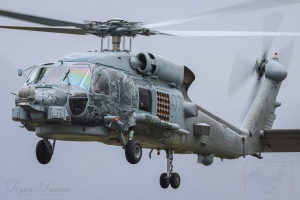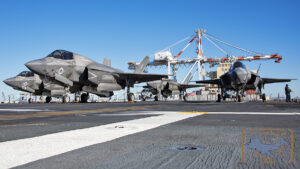Trilateral Naval Logistics Arrangement for Further Cooperation Signed.
Naval aircraft, ships and land based forces benefit from cooperative signing in Brisbane Australia prior to the commencement of Talisman Sabre 2025.
REPORT: Jaryd Stock
Sydney- Senior United States, Australian and Japanese flag officers agreed yesterday to further enhance logistics interoperability among their maritime forces. Their intent is to enable deeper maritime cooperation among the three nations, building upon their enduring commitment to stability and security in the Indo-Pacific.
Vice Adm. Jeff Jablon (Deputy Chief of Naval Operations for Installations and Logistics, OPNAV N4), Rear Adm. Naoya Hoshi (Director General of Logistics Department, Maritime Staff Office, Japan Maritime Self Defense Force (JMSDF)), and Commodore Catherine Rhodes (Director General Logistics, Royal Australian Navy (RAN)) took part in the signing ceremony aboard USS America (LHA-6) during a port visit in Brisbane.
The U.S. Navy, JMSDF, and RAN routinely collaborate on a bilateral basis for logistics and other topics under a strategic dialogue framework that has been in place for several years. This is the first time a trilateral logistics agreement has been established under this framework.

Royal Australian Navy Sikorsky MH-60R Romeo- Ryan Imeson
“Sustainment in depth is a primary objective,” said Vice Adm. Jablon. “We have robust logistics partnerships with Japan and Australia to ensure we can provide the right material and services at the right place, at the right time to mutually support our maritime forces, from day-to-day training during peacetime through contingencies. This arrangement strengthens those commitments and allows us to more easily share information, technologies and processes for greater logistics resiliency.”
Reloading missile systems and flexible refueling are among the areas of cooperation outlined in the agreement.
RAN and U.S. Navy forces have supported missile reloading for each other’s warships in the Indo-Pacific region since 2019. To enhance the capability to reload rapidly at sea, Naval Sea Systems Command (NAVSEA) is developing prototype systems that are compatible with both existing U.S. and partner nation warships’ MK-41 missile launchers and can be utilized to transfer missile canisters between ships in elevated sea states. These systems were demonstrated in 2024, with demonstrations planned in 2025 and 2026 to showcase additional capability and interoperability.
Refueling naval vessels at sea is fundamental to the ability to maintain presence and respond to contingency situations. U.S., Australian and Japanese military oilers routinely refuel partner nation vessels while participating in combined joint exercises and other cooperative engagements. To augment oiler capability, since 2011 the Military Sealift Command (MSC) has been outfitting leased commercial tanker ships with consolidated tanking, or CONSOL, connections that enable them to refuel a U.S. or partner nation military oiler at sea.

The Nimitz-class aircraft carrier USS Carl Vinson (CVN 70) conducts a vertical replenishment with the Lewis and Clark-class dry cargo ship USNS Cesar Chavez (T-AKE 6) in the U.S. Central Command area of responsibility. (Official U.S. Navy photo)
This allows the oiler to remain on station for longer periods and continue refuelling operational forces, rather than returning to a port to refuel. Since 2022, MSC has ramped up CONSOL operations and related training with Australia, Japan, and other partners. The U.S. Navy is currently exploring how partner nation tankers could incorporate CONSOL capabilities.
“Japan is excited about the chance to collaborate more closely with our U.S. and Australian partners,” said Rear Adm. Hoshi. “This new arrangement will allow us to broaden the scope and increase the efficiency of our interactions.”
Beyond information and technology sharing through these types of agreements, incorporating logistics activities into training in a realistic manner remains a focus area for U.S. naval forces. Examples include offloading missiles from dry cargo/ammunition ships, rearming cruisers and destroyers, refueling at sea, ship and aircraft repair, airfield damage repair, salvage operations, and medical evacuations.
Looking at the aviation element from all three nations there is commonality between them all, the nations for example all operate variants of the Sikorsky Seahawk helicopter and all nations operate variants of the F-35, for instance even though the Royal Australian Air Force operate the F-35A, under this agreement for increased logistical cooperation the U.S. Navy F-35C variants could greatly be enhanced by established supply and logistic chains when deployed to Australia.
This agreement is about building the supply network behind the frontline fighters, and for a long time Australia has suffered from the Tyranny of distance being in the South West Pacific. This agreement helps to alleviate somewhat that distance between nations.
With Sikorsky working with Australian based defence industry by building and setting up supply chain networks at HMAS Albatross in Nowra to support MH-60R Romeo operations, and announcing the investment of a new maintenance facility at Holsworthy barracks in Sydney to support Australian Army UH-60M Black hawks these logistical chains are what help keep those operations running whenever called upon by government to act in a time of crisis.

USS America conducting operations in the 7th Fleets AoR, arriving into Sydney for a liberty call- Jaryd Stock.
The signing took place onboard USS America (LHA-6) just prior to the official kickoff of exercise Talisman-Sabre 2025, during which Australia, Japan, and other partners will participate in many of these activities as feasible.
“During Talisman-Sabre and beyond, we have clear opportunities to work trilaterally with our U.S. and Japanese partners on logistics initiatives,” said Commodore Rhodes. “These efforts facilitate our speed of response for the full range of naval actions in the Indo-Pacific, from routine sustainment through crisis.”

VMFA-242 “Bats” onboard the USS America (LHA-6) docked in Brisbane- Jaryd Stock
Jaryd Stock is based in Sydney Australia. He has been a die-hard aviation enthusiast from a young age when he was chauffeured around by his father to various airshows and airports around Australia. At his first Airshow he witnessed the awesomeness of a General Dynamics F-111C and immediately fell in love with aviation.
Jaryd picked up a camera at a young age and has never looked back. He now combines photography and writing to highlight “Downunder” aviation; especially U.S. DoD units. Jaryd uses Nikon cameras and lenses.

